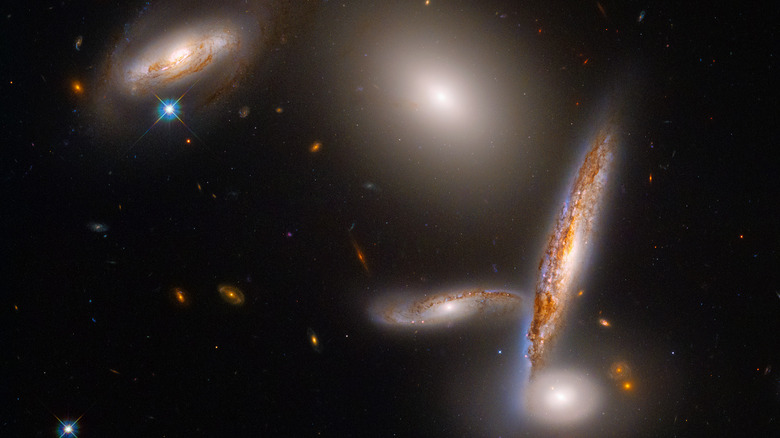Hubble Celebrates Its 32nd Birthday With A Group Of 5 Galaxies
This week will see a special day for all those who are fans of astronomy or of admiring beautiful space images. The Hubble Space Telescope is celebrating its birthday on Sunday, April 24, 2022, which will mark 32 years since the launch of this remarkable instrument in 1990. To commemorate the event, the Hubble team has shared a special image captured by the telescope showing not one, but five galaxies grouped together in what the researchers describe as a "menagerie" (via Hubble).
The gang of galaxies, technically known as the Hickson Compact Group (HCG) 40, are so close together that they will eventually collide and merge into one giant galaxy, though that won't happen for another 1 billion years. In the meantime, the five remain close but separate and include three different types of galaxies. Three of the group are spiral galaxies, like our Milky Way, while one is an elliptical galaxy (meaning it is smooth and without spiral arms), and the last is a lenticular galaxy, which is halfway between a spiral galaxy and an elliptical galaxy.
While it is relatively common to see two galaxies merging, and even to see groups of galaxies close together, this particular group is one of the densest observed to date, according to experts. "Caught in a leisurely gravitational dance, the whole group is so crowded that it could fit within a region of space that is less than twice the diameter of our Milky Way's stellar disk," Hubble scientists write.
Learning about dark matter
As well as being a neat image, collecting data on such a densely packed group of galaxies can help astronomers learn about dark matter. Normally, dense groups of galaxies are found in the center of enormous galaxy clusters, but this particular group is out on its own, relatively far from other galaxies. Researchers think this might be because these galaxies are hosting a large amount of dark matter.
Dark matter is a mysterious substance, as physicists know that it must exist based on the movement of galaxies – in fact, it is not only present in our universe, but also makes up more than a quarter of the mass of everything that exists. With that said, dark matter can't be detected directly (via Digital Trends). In the case of HCG 40, there could be a large amount of dark matter around the five galaxies, forming a large cloud around them. This cloud provides resistance that slows the movement of the individual galaxies and binds them together.
Studying unusually dense galaxy groups like this can also help astronomers understand how galaxies formed and evolved. "I remember seeing this on a sky survey and saying, 'Wow look at that!'" said Paul Hickson, an astronomer at the University of British Columbia, Vancouver, who rediscovered this group while looking through a sky atlas from the 1960s. "All that I was using at the time was a big plastic ruler and a magnifying glass while looking over sky survey prints."
